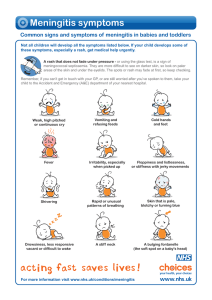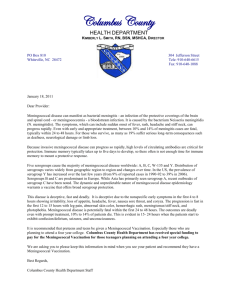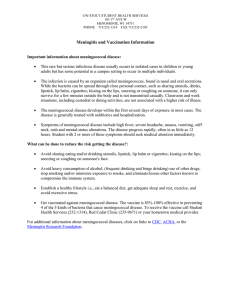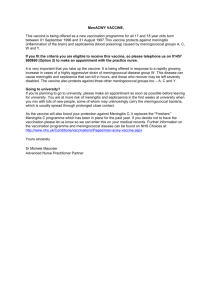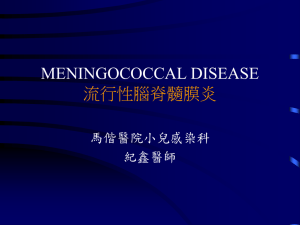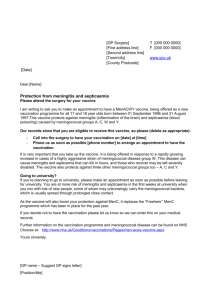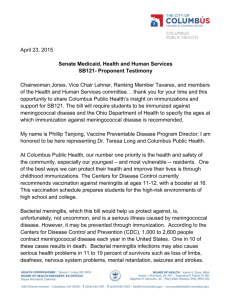Meningococcal Disease April 2012
advertisement
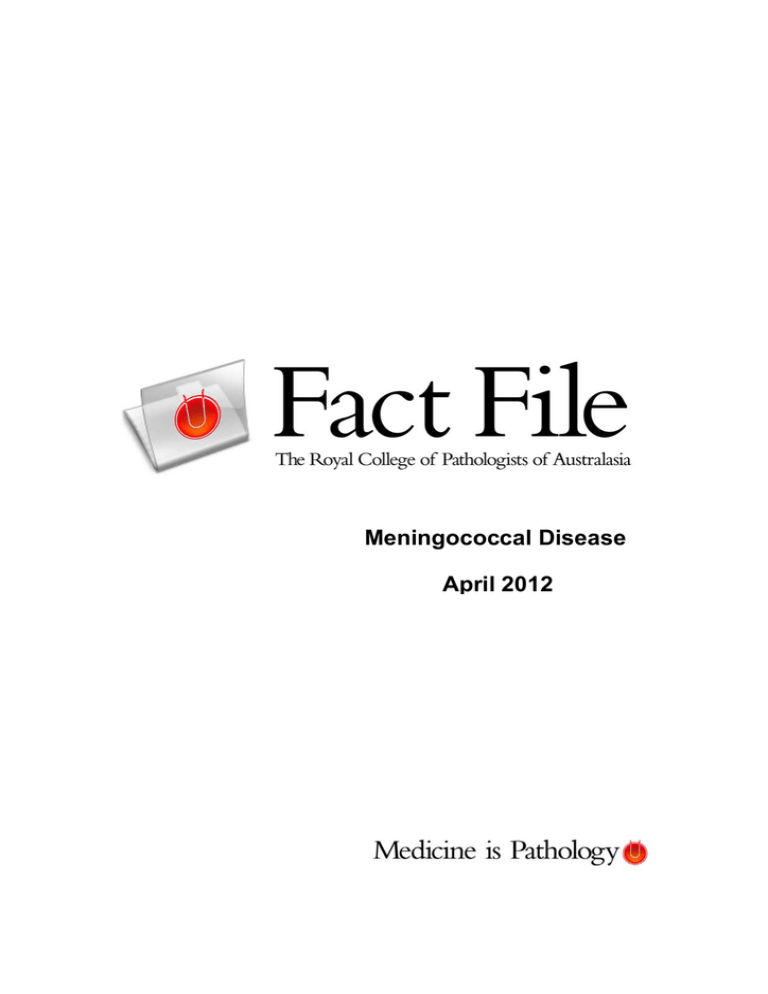
Meningococcal Disease April 2012 Meningococcal Disease 1. Cause Neisseria meningitidis is acquired in the nasopharynx through respiratory droplets spread from an asymptomatic carrier of a potentially pathogenic strain. Infection occurs if organisms move into the bloodstream in patients with no prior immunity induced by contact with non-pathogenic, cross-reacting Neisseria (1). 2. Means of spread It is spread in the fine droplets that are shed through coughing, sneezing and spluttering. Both active and passive smoking appear to increase the risk of the disease (3). Rates of disease Australia has a rate of 1-2 per 100 000 population. Most cases occur sporadically, although reports of clusters of related cases have increased in the last decade. It shows a seasonal incidence in the winter and spring months (1). A bimodal age distribution has emerged with the highest rates of infection occurring in the 0-4 years age group, and a second peak in the 15-25 years age group (1, 2). Currently a conjugate immunisation is available for serogroup C. While the older polysaccharide vaccines for A, C, Y and W135 have been available for many years, the polysaccharide vaccine for C only gives short term protection. No vaccine has been developed against serogroup B. Serogroup B has historically been more common in Australia, however prevalence of serogroup C is increasing (2). Signs and symptoms Meningitis Meningococcal meningitis is clinically similar to other forms of acute bacterial meningitis, with the sudden onset of headache, fever, neck stiffness, vomiting and photophobia. In young children, signs of meningitis may be absent and presentation may be of a non-specific febrile illness with a bulging fontanelle (1, 3). Septicaemia The characteristic feature of meningococcal septicaemia, with or without meningitis, is a haemorrhagic rash. But the rash may not appear until late in the course of the infection and absence of a rash does not mean that it is not meningococcal disease. The septicaemic form can progress very rapidly and is associated with higher mortality. The rash is commonly petechial, purpuric or ecchymotic and does not blanch with pressure. In the early stages, it may be transient or maculopapular. It is more obvious in areas where there is pressure from clothing; a thorough examination of the skin is necessary (1,3). Symptoms in infants include Fever Refusing to take feeds Fretfulness Child difficult to wake Rash especially if reddish-purple spots or bruises High pitched or moaning cry Pale or blotchy skin 3. Symptoms in older children and adults include Headache Fever Vomiting Neck stiffness and joint pains Drowsiness or confusion Rash, especially if reddish-purple spots or bruises Discomfort when looking at bright lights Treatment Diagnostic tests should not delay the commencement of antibiotics. General practitioners are encouraged to administer benzyl penicillin parenterally as soon as septicaemia is suspected and before transfer to hospital (1,3). Patients with suspected meningococcal infection should be referred for admission to hospital, and receive benzyl penicillin prior to transfer. For patients hypersensitive to penicillin (unless there is immediate hypersensitivity) give a single dose of ceftriaxone. If there is a history of immediate hypersensitivity to penicillin, the patient should go to a hospital as soon as possible, where expert advice can be sought on appropriate treatment. If a GP sends a patient to the hospital with a suspicion of invasive meningococcal disease, the patient should be assessed urgently (3). 4. Diagnostic testing No rapid laboratory tests are presently available to affect initial clinical diagnosis and management. Although NAA1 can be performed in several hours, it is done in relatively few laboratories (1). 1 Nucleic Acid Amplification Summary of tests available to diagnose meningococcal disease (3) Test Specimen Gram’s stain CSF, skin lesion, joint fluid or other normally sterile site. Culture A) CSF, blood, skin lesion, joint fluid or other normally sterile site. B) Throat swab NAA test CSF, blood See note below. Serology Blood Utility Rapid, readily available Confirms diagnosis if +ve from a sterile site in a clinically compatible case. Sensitivity in CSF: 65% Sensitivity from skin lesions: 30-70% Results in 24-48 hrs. +ve result confirms diagnosis. Sensitivity in CSF 95% if no prior antibiotics. Sensitivity in blood 50% if no prior antibiotics. 5% if prior antibiotics. +ve result supports diagnosis in a clinically compatible case. +ve result confirms diagnosis in a clinically compatible case. Can determine serogroup without a +ve culture. Sensitivity in CSF 89%, specificity 100%. Sensitivity in blood (buffy coat) 81%, specificity 97%. Single +ve IgM or rising convalescent titre confirms diagnosis in a clinically compatible case. Sensitivity in adults and older children > 97%. Sensitivity relates to the test’s ability to detect the presence of the disease. Specificity relates to how accurately and precisely it detects the disease. Nucleic acid testing for Meningococcal disease is developing at a fast pace with new and improved methods being reported (4). 1. Munro R Meningococcal disease: treatable but still terrifying .Internal Medicine Journal 2002; 32: 165-169. 2. Roche P et al. Communicable Diseases Intelligence Vol 25 No 3 http://www.health.gov.au/pubhlth/cdi/cdi2503/cdi2503i.htm accessed 27/8/02 3. Communicable Diseases Network of Australia. Guidelines for the early clinical & public health management of Meningococcal disease in Australia. 2001. 4. Diggle M.A, et al. J Clin. Microbiol. Dec 2001; 4518-4519. Resources and References http://www.health.gov.au/internet/main/publishing.nsf/Content/BC329B583B663546CA2 5736D007674AA/$File/meningococcal-guidelines.pdf Covers everything. http://ideas.health.vic.gov.au/bluebook/meningococcal.asp http://ideas.health.vic.gov.au/diseases/meningococcal-facts.asp http://ideas.health.vic.gov.au/diseases/meningococcal-advice.asp Info for public and medical practitioners. http://health.vic.gov.au/immunisation/fact-sheets/factsheets/mening_seroc Info about serogroup C immunisation for babies. http://www.rch.org.au/kidsinfo/handout/index.php?doc_id=3738 http://www.rch.org.au/clinicalguide/cpg.cfm?doc_id=5224 Public awareness, and clinicians’ guide. http://www.health.nsw.gov.au/factsheets/infectious/meningococcal.html Public awareness of symptoms and focusing on public health response.
